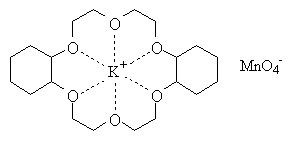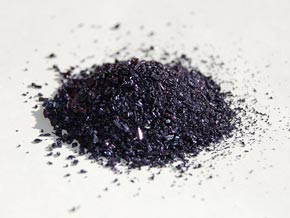|
HOME >>
Chemicals
>>
Chemicals List 2 >> Potassium
permanganate
Potassium permanganate
CAS number 7722-64-7


Identification
Synonyms: Permanganic acid, potassium salt; Condy's crystals
CAS No.: 7722-64-7
Molecular Weight: 158.03
Chemical Formula: KMnO4
PubChem 24400
EC number 231-760-3
UN number 1490
KEGG D02053
RTECS number SD6475000
Properties
Molar mass 158.03 g/mol
Appearance purplish-bronze-gray needles, magenta–rose in soln.
Density 2.703 g/cm3
Melting point 240 °C decomp.
Solubility in water 6.38 g/100 ml at 20 °C
Structure Crystal structure Orthorhombic
Thermochemistry Std enthalpy of formation ΔfHo298 −813.4 kJ/mol
Standard molar entropy So298 171.7 J K−1 mol−1
Hazards
MSDS External MSDS
EU Index 025-002-00-9
EU classification Oxidant (O)
Harmful (Xn)
Dangerous for the environment (N)
R-phrases R8, R22, R50/53
S-phrases (S2), S60, S61
Flash point Non-flammable
Potassium permanganate is the inorganic chemical compounda water
soluble salt consisting of equal mole amounts of potassium (K+) and
permanganate (MnO4-, officially called manganate (VII) ) ions. This
salt, formerly known as permanganate of potash or Condy's crystals
is a strong oxidizing agent. It dissolves in water to give deep
purple solutions, evaporation of which gives prismatic
purplish-black glistening crystals.[1] In 2000, worldwide production
was estimated at 30 000 tonnesIn this compound, manganese is in the
+7 oxidation state.
Uses
Almost all applications of potassium permanganate exploit its
oxidizing properties
Ass a strong oxidant that does not generate toxic byproducts, KMnO4
has many niche uses. One of the uses can be said to be as a
fixative.
Disinfectant and water treatment
As an oxidant, potassium permanganate can act as a disinfectant. For
example, dilute solutions are used to treat canker sores (ulcers),
disinfectant for the hands and treatment for mild pompholyx,
dermatitis,[3][4] and fungal infections of the hands or feet
Potassium permanganate, obtainable at pool supply stores, is used in
rural areas to remove iron and hydrogen sulfide (rotten egg smell)
from well and waste water.
Biomedical uses
Related to the use of KMnO4 for water treatment, this salt is often
employed as a specialized disinfectant for treating human and animal
ailments. It has been used to induce abortions, although with risks.
In histology to bleach melanin which obscures tissue detail.
Potassium permanganate can also be used to differentiate amyloid AA
from other types of amyloid pathologically deposited in body
tissues. Incubation of fixed tissue with potassium permanganate will
prevent amyloid AA from staining with congo red whereas other types
of amyloid are unaffected.
Hazards Identification
DANGER! STRONG OXIDIZER. CONTACT WITH OTHER MATERIAL MAY CAUSE FIRE.
CORROSIVE. CAUSES BURNS TO ANY AREA OF CONTACT. HARMFUL IF SWALLOWED
OR INHALED. Potential Health Effects Inhalation:
Causes irritation to the respiratory tract. Symptoms may include
coughing, shortness of breath. High concentrations can cause
pulmonary edema.
Ingestion:
Ingestion of solid or high concentrations causes severe distress of
gastro-intestinal system with possible burns and edema; slow pulse;
shock with fall of blood pressure. May be fatal. Ingestion of
concentrations up to 1% causes burning of the throat, nausea,
vomiting, and abdominal pain; 2-3% causes anemia and swelling of the
throat with possible suffocation; 4-5% may cause kidney damage.
Skin Contact:
Dry crystals and concentrated solutions are caustic causing redness,
pain, severe burns, brown stains in the contact area and possible
hardening of outer skin layer. Diluted solutions are only mildly
irritating to the skin.
Eye Contact:
Eye contact with crystals (dusts) and concentrated solutions causes
severe irritation, redness, blurred vision and can cause severe
damage, possibly permanent.
Chronic Exposure:
Prolonged skin contact may cause irritation, defatting, and
dermatitis. Chronic manganese poisoning can result from excessive
inhalation exposure to manganese dust and involves impairment of the
central nervous system. Early symptoms include sluggishness,
sleepiness, and weakness in the legs. Advanced cases have shown
symptoms of fixed facial expression, emotional disturbances, spastic
gait, and falling.
Aggravation of Pre-existing Conditions:
No information found.
Handling and Storage
Keep in a tightly closed container, stored in a cool, dry,
ventilated area. Protect against physical damage and moisture.
Isolate from any source of heat or ignition. Avoid storage on wood
floors. Separate from incompatibles, combustibles, organic or other
readily oxidizable materials. Containers of this material may be
hazardous when empty since they retain product residues (dust,
solids); observe all warnings and precautions listed for the
product.
| |
|
Note /Government
Notification: These chemicals are designated as those that are
used in the manufacture of the controlled substances and are
important to the manufacture of the substances. For any (Control
Substance) products Import and Export *** subjected to your
country government laws /control substance ACT.
Information: The information on this web page is provided to
help you to work safely, but it is intended to be an overview of
hazards, not a replacement for a full Material Safety Data Sheet
(MSDS). MSDS forms can be downloaded from the web sites of many
chemical suppliers. ,also that the information on the PTCL
Safety web site, where this page was hosted, has been copied
onto many other sites, often without permission. If you have any
doubts about the veracity of the information that you are
viewing, or have any queries, please check the URL that your web
browser displays for this page. If the URL begins "www.tajapi.com/www/Denatonium
Benzoate.htm/" the page is maintained by the Safety Officer in
Physical Chemistry at Oxford University. If not, this page is a
copy made by some other person and we have no responsibility for
it.
The Controlled Substances Act (CSA) was enacted into law by the
Congress of the United States as Title II of the Comprehensive
Drug Abuse Prevention and Control Act of 1970.[1] The CSA is the
federal U.S. drug policy under which the manufacture,
importation, possession, use and distribution of certain
substances is regulated. The Act also served as the national
implementing legislation for the Single Convention on Narcotic
Drugs |
|
|
 New Chemicals New Chemicals
Diethyl ether,
Potassium permanganate,
Toluene,
Diethyl ether,
Potassium permanganate,
Methyl isobutyl ketone,
Para Anisyl Choride,
Methyl Tyramine,
Para
Cresyl Acetate,
Anisyl Formate,
Ortho Anisic Aldehyde,
3-Benzyloxy Propionitrile,
Veratrol,
Manganese Sulphate Monohydrate |



